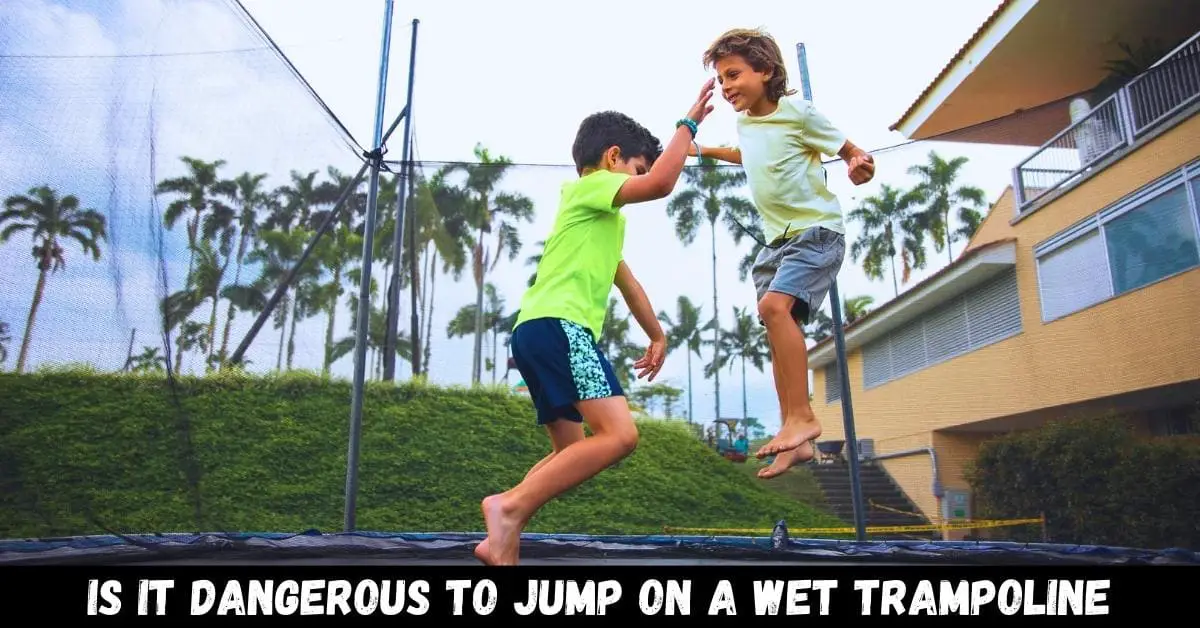Are you worried about “Is it dangerous to jump on a wet trampoline”? Yes, you can jump on a wet trampoline, but it’s crucial to exercise extra caution due to the increased slipperiness.
It’s important to prioritize safety in such situations. Before taking that leap, I recommend taking the time to thoroughly wipe down the trampoline surface, minimizing moisture as much as possible.
Doing so can significantly reduce the risk of accidents caused by slippery conditions. As someone who loves trampolining, I understand the thrill it brings, but safety should always come first.
So, remember to be mindful of the potential hazards and take the necessary precautions. By taking these simple steps, I can continue to enjoy the exhilarating experience of jumping on a wet trampoline while minimizing the associated risks.
Is it dangerous to jump on a wet trampoline: Jumping on a wet trampoline can be dangerous due to reduced traction. Slippery conditions increase the risk of falls and injuries. Take precautions and dry the surface before use to ensure safety.
Are Wet Trampolines Slipperier?
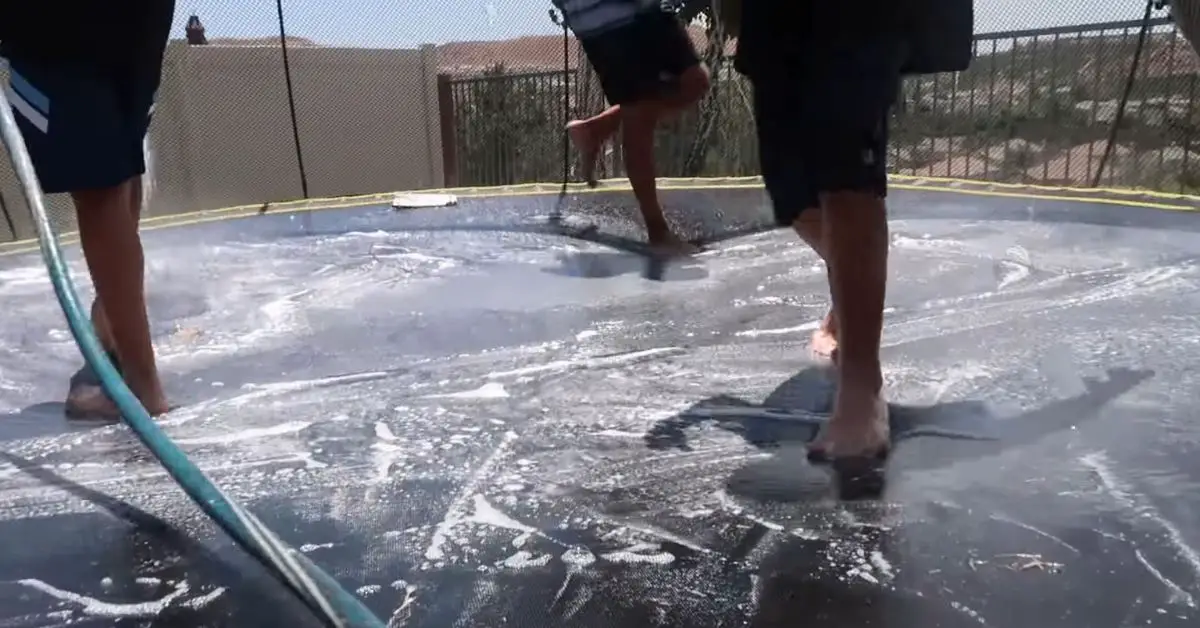
Your adventurous kids might enjoy the slippery sensation of jumping on a wet trampoline, but it poses more risks. When trampolines get wet, they become very slippery, making it harder to stay in control.
While trampoline manufacturers usually recommend only one person jumping at a time, it’s more fun to have friends join in. However, jumping together increases the chances of colliding with each other.
With less traction and control, wipeouts can happen, and it’s not fun when everyone falls on top of you.
In summary, wet trampolines can be dangerous, so it’s important to be cautious. If you’re concerned about your kids jumping on a wet trampoline, establish some usage rules.
Keep an eye on them to prevent collisions, especially if you don’t have a safety net. A safety net can help reduce slipping and falling off the trampoline.
Remember, safety should always come first when it comes to enjoying trampoline fun with your children.
Can Jump on Wet Trampolines Cause Damage to the Trampoline?
The trampoline’s frame and springs are designed to resist rust, so jumping on a wet trampoline won’t ruin it. The mat may become slightly heavier if it holds some water, but it won’t affect the trampoline’s structure.
The springs are not affected by being wet, but if you intentionally wet the trampoline, make sure the spring cover is in good condition to prevent rusting.
A quality trampoline mat is water resistant, so it won’t collect water during rainy weather. It can handle the same pressure whether wet or dry.
Water trampolines, found at resorts or lake communities, have the advantage of falling into the water instead of solid ground for safety. If your child wants to jump on a wet trampoline, establish safety rules and encourage them to wear swimwear as they will likely get wet themselves.
Lastly, continue to maintain your trampoline for future jumping under different conditions.
Under What Circumstances Does a Trampoline Become Wet?
Trampolines get wet when it rains, snow melts, or when lawn sprinklers are on. Sometimes, on hot days, people might use a garden hose to spray water on the trampoline while kids are jumping.
Regular trampolines are made for outdoor use and can handle various weather conditions. The frame and springs are protected from rust, and the mat is weatherproof.
The safety net is also made of a type of plastic. The only part that may deteriorate faster when it gets wet is the safety pads covering the springs.
Does a Wet Trampoline Provide a Higher Bounce, and What is the Reason Behind it?
Many kids claim that they can jump at least a foot higher on wet trampolines. There are a couple of possible explanations for this.
The first idea is that it might be a trick of perception. The change in angles due to the water on the trampoline might make kids feel like they are bouncing higher.
The water drops on the trampoline surface might also create a small secondary bounce, making it seem like they are jumping further.
The second idea is that wet trampolines provide a higher bounce. This could be because the water on the trampoline evaporates and cools it down.
When the trampoline moves, the colder mat wants to quickly return to its original shape, resulting in a stronger rebound. This forces the kid bouncing on the trampoline to go higher.
While the second theory hasn’t been scientifically tested, it does sound plausible.
Is it Safe to Jump on a Trampoline During Wet Weather?
It is generally safe to jump on a trampoline in wet weather, except during electrical storms or thunderstorms where there is a risk of getting electrocuted.
When it’s raining, the trampoline will be wet and the wet mat can become slippery, posing a safety hazard. However, during electrical storms or thunderstorms, the metal parts of the trampoline, such as the safety net poles, can act as conductors for lightning.
The electricity can travel through the metal poles and the water on the trampoline, increasing the risk of getting shocked. It can also be challenging to safely get off the trampoline without touching the metal frame or ladder.
In summary, it’s important to avoid jumping on a trampoline during electrical storms or thunderstorms to ensure your safety.
Is It Dangerous to Jump on a Wet Trampoline?
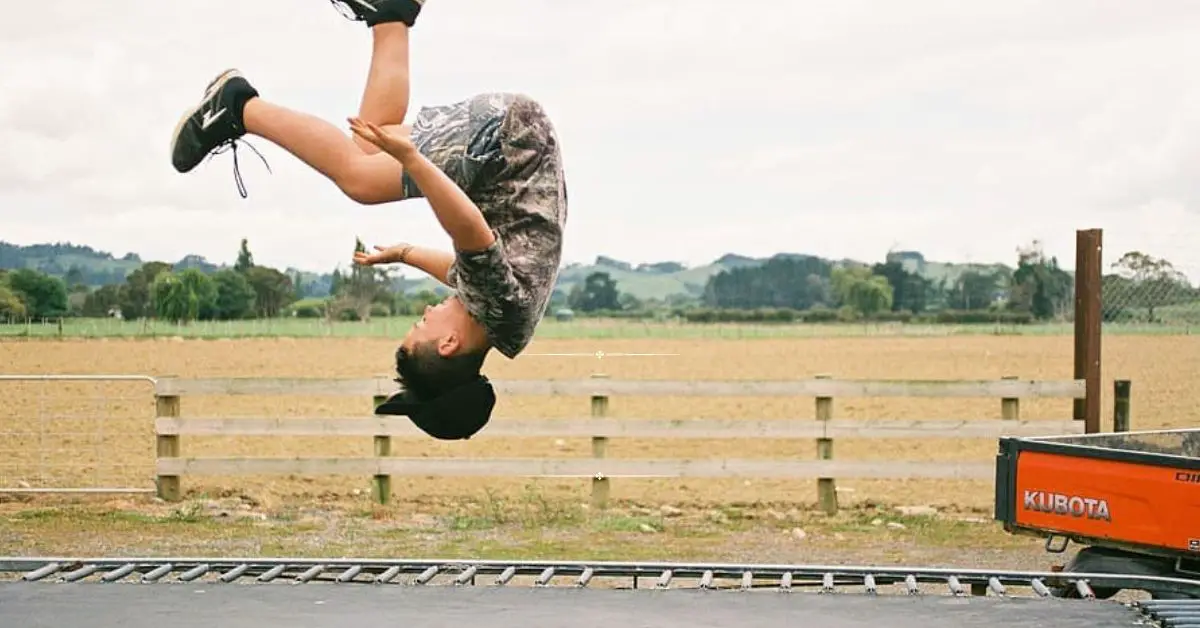
Jumping on a wet trampoline can be dangerous due to reduced traction and increased slipperiness. It’s important to take precautions and follow safety guidelines to minimize the risks involved.
Here are some key areas to consider for safer trampoline jumping:
Ensuring Safe Trampoline Access with Ladder Usage:
Ladder safety is often overlooked when it comes to trampolines, and it’s especially important to consider when the trampoline is wet. Take the following precautions to ensure a safer trampoline experience:
- Keep the ladder dry: If possible, make sure the ladder remains dry. Wet surfaces can increase the chances of slipping and accidents.
- Assist: Instead of relying solely on the ladder, personally assist your children in climbing onto the trampoline. This way, you can help them maintain balance and prevent potential injuries such as leg scrapes or ankle twists on the ladder steps.
By being proactive in keeping the ladder dry and offering direct assistance, you can minimize the risks associated with trampoline usage, particularly in wet conditions. Prioritizing ladder safety adds an extra layer of protection and peace of mind for both children and adults.
Establishing Guidelines and Providing Adequate Supervision:
Setting ground rules and closely supervising trampoline use in wet conditions is crucial, especially for younger children who may have less coordination and strength.
Ideally, it’s best to avoid trampoline jumping when it’s wet. However, if you decide to proceed, establish clear guidelines to ensure safety. Start by allowing only one person to jump at a time, particularly on smaller trampolines. This reduces the risk of tripping and collisions between children.
While larger circular and rectangular trampolines offer more space to maintain a safe distance, there is still a potential risk. Therefore, it’s important to remain vigilant and closely monitor trampoline activity to prevent accidents and ensure everyone’s well-being.
By setting rules and providing adequate supervision, you can help minimize the risks associated with jumping on a wet trampoline.
Enhancing Safety with Jumping Mats and Safety Nets:
Preventing injuries from landing outside the trampoline or going over the edge is crucial during wet conditions.
When the trampoline is wet, slips and slides are more likely to happen, leading to potential accidents near the edge.
To enhance safety, it’s essential to have an enclosure net that surrounds the trampoline, along with protective padding for the frame and springs. These safety features help prevent users from falling off and getting injured.
Additionally, anchoring the trampoline is highly recommended to avoid unnecessary movement or shifting, further reducing the risk of accidents.
By prioritizing the use of safety nets, padding, and proper anchoring, you can provide a safer environment for trampoline jumping, particularly when it’s wet, and minimize the chances of injuries occurring.
Should You Protect Your Trampoline from Rain?
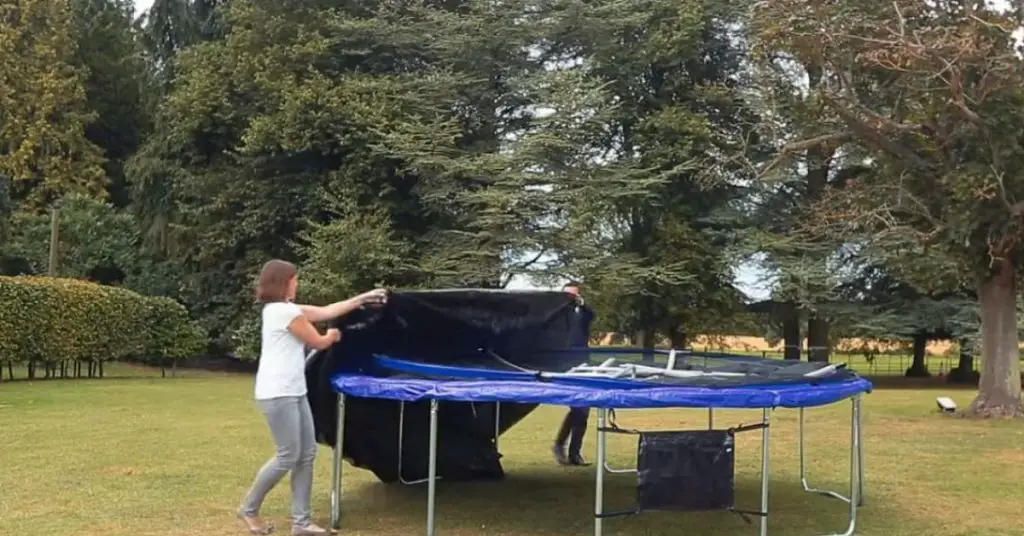
Is it necessary to protect your trampoline from rain? While it may not be a requirement, it is highly recommended, especially if you live in a rainy area.
Rain can have negative effects on your trampoline, such as causing corrosion to the springs over time.
Additionally, continuous exposure to water can turn dirt and dust on the jumping mat into the mud, which can accumulate in the crevices and lead to faster wear and tear.
Furthermore, leaves, twigs, and branches can land on the trampoline and potentially puncture the jumping mat, rendering it unusable.
To keep your trampoline in good condition and prolong its lifespan, investing in weather-proofing measures is advisable. These measures can help prevent damage caused by rain, maintain the cleanliness of the trampoline, and ensure its long-term usability.
Tips for Protecting Your Trampoline from Rain.
Here are some tips to protect your trampoline from rain:
- Use a waterproof spring pad: Make sure your trampoline has a sturdy and waterproof spring pad that covers the springs and upper frame tube. This will keep them protected from direct rainwater contact and also prevent injuries and friction burns.
- Get a trampoline cover: Invest in a high-quality trampoline cover that can be placed over the entire trampoline, including the jumping mat. This cover will safeguard the trampoline from debris, dust, and harmful UV rays. Remember to put the cover on whenever the trampoline is not in use.
- Clear rainwater and snow: If rainwater collects on the cover, make sure to remove it to prevent the mat from becoming too heavy. Similarly, if it snows, gently remove the snow from the trampoline without letting it get underneath.
By following these tips, you can effectively protect your trampoline from rain, prolong its lifespan, and ensure a safer and more enjoyable jumping experience.
A Wet Trampoline: How Do I Dry It?
To effectively dry a wet trampoline, follow these steps:
- Obtain a clean and dry cloth or towel: Before you start drying your wet trampoline, make sure you have a cloth or towel that is clean and free from any dirt or moisture. This will help prevent any additional wetness on the trampoline.
- Wipe the surface with the cloth: Begin wiping the surface of the trampoline using the cloth or towel. Focus on areas where water has accumulated, such as puddles or damp spots. Use a sweeping motion to absorb the moisture and remove any excess water. Be thorough in your wiping to ensure effective drying.
- Pay attention to the jumping surface: The jumping surface of the trampoline tends to retain more moisture. Take extra care to wipe this area thoroughly. By minimizing the amount of water on the jumping surface, you can reduce slipperiness and create a safer environment for jumping.
- Use a blower or air compressor (if available): If you have access to a blower or air compressor, use it to blow air across the trampoline’s surface. This will help disperse any remaining moisture and speed up the drying process. Move the blower or air compressor around to cover all areas of the trampoline, including the mat, springs, and frame.
- Ensure complete dryness: Continue blowing air or wiping until the trampoline feels dry to the touch. Check different sections of the trampoline to ensure no damp spots are remaining. It’s important to be thorough to avoid any potential slip hazards.
By following these steps, you can effectively dry your wet trampoline, making it ready for safe and enjoyable use.
Trampoline Mist Sprayer: What is it?
A trampoline misting system, also called a trampoline sprinkler, is a device that is installed underneath the trampoline to spray a fine mist of water onto the jumping surface. It’s designed to keep you cool while jumping, especially on hot days.
This is especially helpful if you live in a hot area and want to avoid getting too hot while using the trampoline. Moreover, many kids find it exciting to be splashed with water as they bounce, which adds an extra element of fun to the trampoline experience.
Is it Safe to Use Trampoline Sprinklers?
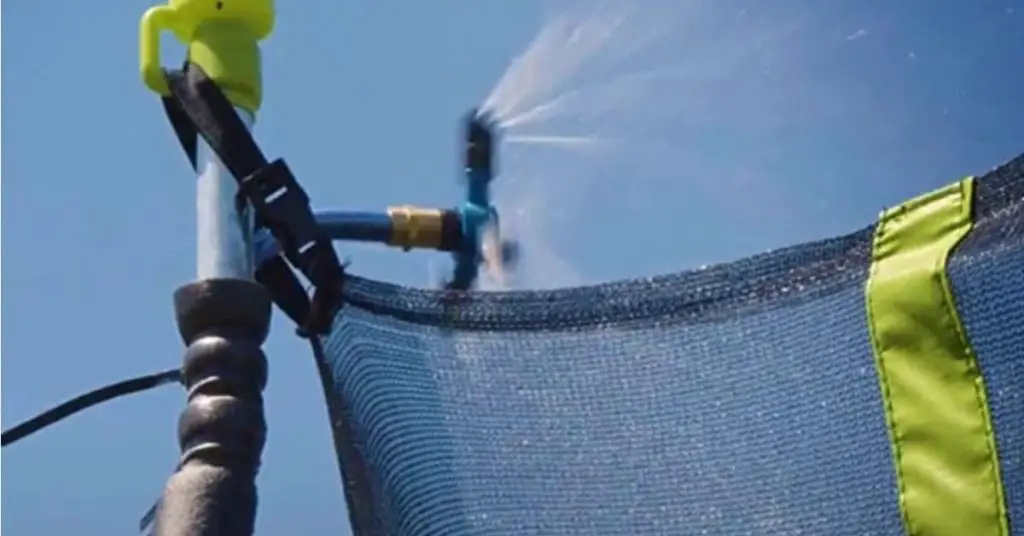
Are trampoline sprinklers safe to use? Absolutely! Trampoline sprinklers are a fun and safe way to enjoy your trampoline, especially in the summer.
They are usually attached to the trampoline’s handles and spray water over the surface, making it wet and slippery.
This adds an exciting element to jumping as you and your family get soaked by the water while bouncing. It’s a great way to have a blast and cool down on hot days!
Potential Hazards of Jumping on a Wet Trampoline
Jumping on a wet trampoline can pose certain hazards that you should be aware of.
Reduced Traction
When a trampoline is wet, the presence of water on the surface can significantly decrease traction. The water creates a slick and slippery surface, making it more challenging to maintain a solid grip while jumping.
With reduced traction, jumpers may struggle to find their footing and maintain control over their movements. This can lead to an increased risk of slipping and losing balance, potentially resulting in falls and accidents.
Increased Risk of Injury
Jumping on a wet trampoline introduces the possibility of unexpected movements due to the slippery conditions. When jumpers land or push off from the surface, the lack of traction can cause their feet to slide or skid unexpectedly.
These sudden movements can strain or twist muscles, leading to sprains and strains. In more severe cases, the lack of control and stability may result in fractures or other impact-related injuries.
The reduced grip caused by the water on the trampoline surface also increases the risk of falling off the trampoline. Without sufficient traction, it becomes more challenging for jumpers to maintain their position on the jumping mat.
This can be particularly dangerous if they attempt acrobatic moves or lose balance during their jumps. Falling off the trampoline can result in more severe injuries, such as fractures, head injuries, or sprains from landing on uneven or hard surfaces surrounding the trampoline.
To mitigate these risks, it is essential to exercise caution and take appropriate safety measures when jumping on a wet trampoline. This includes ensuring proper supervision, allowing only one person to jump at a time, and establishing rules to prevent excessive bouncing or risky maneuvers.
It’s also advisable to use safety equipment, such as a safety net and padding, to minimize the impact of falls and provide additional stability.
By prioritizing safety and being mindful of the potential hazards, the risks associated with jumping on a wet trampoline can be significantly reduced.
Safety Precautions and Tips
Here are some safety precautions and tips:
A. Proper Maintenance
- It is important to regularly inspect and maintain the trampoline to prevent water accumulation. This includes checking the drainage systems and ensuring they are clear to allow water to flow off the trampoline easily.
- Consider investing in waterproof coverings or tarps that can be used to protect the trampoline during rainy periods. These coverings help to keep the jumping surface dry and reduce the risk of slipping.
Use Safety Equipment
- Use safety pads that cover the springs and frame of the trampoline to provide cushioning and reduce the risk of injury if a fall occurs. These pads should be securely attached and in good condition.
- Install an enclosure net around the trampoline to create a barrier and prevent users from falling off. Additionally, encourage the use of non-slip footwear to enhance traction and stability while jumping. Following the manufacturer’s guidelines for safety equipment usage is crucial for optimal protection.
Supervision and Age Restrictions
- Adult supervision is essential, especially when younger children are using the trampoline. An adult should closely monitor the activity to ensure safe jumping practices and intervene if any unsafe behavior is observed.
- Be aware of any specific age restrictions or guidelines recommended by the trampoline manufacturer. These guidelines may outline the appropriate age range or weight limit for safe usage, taking into consideration the trampoline’s design and capacity.
By following these safety precautions and tips, the risks associated with jumping on a trampoline, particularly in wet conditions, can be minimized.
Creating a safe environment and promoting responsible trampoline usage will help prevent accidents and ensure an enjoyable experience for everyone involved.
Related article: How To Anchor A Water Trampoline
FAQs:
Q:1 Is it safe to use a trampoline when it’s wet?
You can jump on a trampoline when it’s raining or wet, but you need to be careful as there is a higher risk of slipping or sliding. It’s important to have a safety net in place to prevent accidents.
Jumping in wet weather won’t harm the trampoline itself, but avoid using it during lightning storms for safety reasons.
Q:2 Do you experience higher jumps on a wet trampoline?
When a wet trampoline bounces, the water on it evaporates and takes away heat from the surface. This makes the trampoline colder, and colder elastic materials are less likely to change shape easily.
As a result, when you jump on a wet trampoline, it bounces back more forcefully compared to a dry trampoline which is warmer and softer.
Q:3 What are the methods to dry out a trampoline?
To dry your trampoline quickly, use some big towels. Start by drying the padding first to prevent water from the padding from dripping onto the jump mat.
Once the padding is dry, you can move on to drying the jump mat. In just a few minutes, your trampoline will be dry and ready to be used again.
Q:4 Is it okay to leave a trampoline outside in the rain?
EXIT trampolines are designed to withstand rain. However, it’s important to be aware that heavy rain or snow can create a lot of weight on the trampoline.
Make sure to remove the water or snow promptly to prevent any damage to the springs and to avoid them from becoming loose or sagging. Taking this precaution will help maintain the trampoline’s performance and durability.
Q:5 Are you wet or dry when you jump into water?
Water itself is not considered wet because it is a liquid that can make things wet. When you come into contact with water, you become wet. Before that, when you are not in contact with water, you are considered dry.
Q:6 What is the term for jumping on water?
Diving is a sport where you jump or fall into water from a platform or springboard. People who participate in diving often perform acrobatic movements while in the air before entering the water.
Q:7 What are the effects of jumping high in water?
Even if you jump into the water feet-first in a straight, vertical position, like a pencil, the impact can be very powerful and cause serious injuries. It can compress your spine, break bones, or even give you a concussion.
The force of the water can be so strong that it can knock you unconscious, and there is a risk of drowning even if you survive the initial impact. It’s important to be cautious and aware of the potential dangers when jumping into the water.
Conclusion:
In conclusion, jumping on a wet trampoline can pose certain risks and should be approached with caution. The presence of water on the trampoline surface reduces traction, increasing the likelihood of slipping and losing balance while jumping.
This can result in injuries such as sprains, strains, and fractures due to unexpected movements caused by slippery conditions. Additionally, falling off the trampoline becomes a heightened risk due to reduced grip.
To mitigate these risks, it is important to take safety precautions and follow guidelines. Proper maintenance of the trampoline, including regular inspections and the use of waterproof coverings, can help prevent water accumulation and protect the trampoline during rainy periods.
Using safety equipment such as pads, enclosures, and non-slip footwear can also help reduce the risk of injury. It is crucial to supervise younger children while they use the trampoline and adhere to any age restrictions or guidelines recommended by trampoline manufacturers.
While jumping on a wet trampoline is not necessarily prohibited, it is important to assess the conditions and exercise caution.
By understanding the potential hazards and implementing safety measures, the risks associated with jumping on a wet trampoline can be minimized, allowing for a safer and more enjoyable trampoline experience.
We hope you will be well aware that “is it dangerous to jump on a wet trampoline”, after reading this comprehensive article, feel free to comment below!

